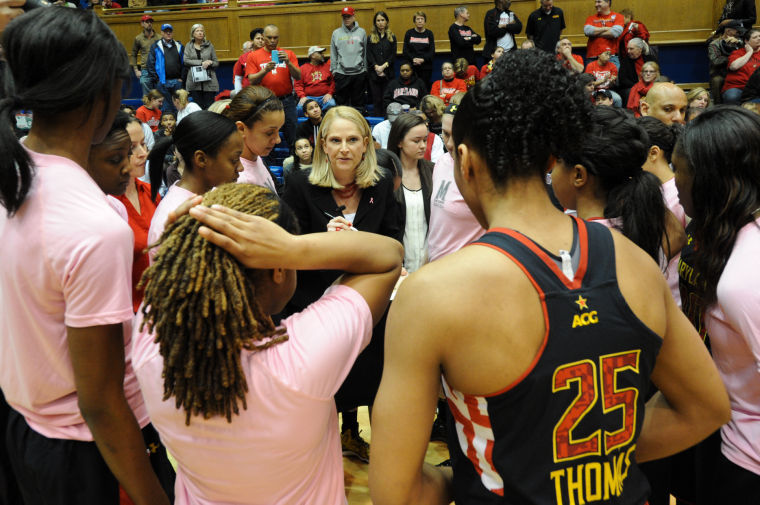
Coach Brenda Frese speaks to the Terps prior to the Terps’ 84-63 loss at Duke on Feb 17, 2014 at Cameron Indoor Stadium.
Despite winning eight of its prior nine games, the Terrapins women’s basketball team’s loss against North Carolina in the ACC quarterfinals Friday brought its record against ranked opponents to 1-4.
The conference tournament presented the No. 11 Terps with a final chance to strengthen their resume before the NCAA tournament selection committee announces the bracket next week. Despite the Terps’ struggles against top competition, ESPN bracketologist Charlie Creme said in a teleconference yesterday that he still expects the Terps to receive a high seed.
The team had a No. 4 seed in Creme’s latest bracketology, which predicted a first-round matchup against No. 13-seed Hampton. The prediction simulates possible seeding and regional placement while taking NCAA rules into account.
“I have them as the 14th overall team on the board,” Creme said. “So that puts them in the second No. 4 seed, North Carolina being the team that’s one slot ahead of them.”
As the second-highest No. 4 seed, the Terps would typically be placed in the second-closest regional, which would be in South Bend, Ind., Creme said. But that location is home to ACC foe Notre Dame, which is expected to be a No. 1 seed, and could set up a Sweet 16 meeting between the two teams. Conference opponents aren’t allowed to face each other before the Elite Eight, so instead, the Terps could end up in the Lincoln, Neb., regional, where Connecticut is expected to be the No. 1 seed.
The Terps lost to both teams during the regular season — UConn also bounced the Terps from last season’s postseason in the Sweet 16 — but proved they could compete against Notre Dame during their slim 87-83 loss on Jan. 27.
“This will give you some insight on how I think and what the committee has to think,” Creme said. “Notre Dame’s the No. 1 seed, same conference. They would meet before the regional final. It’s not allowed to happen, so then Maryland has to move to the next closest region.”
FREE-THROW WOES
With the Terps leading Drexel 64-59 in the final minutes of their Nov. 25 matchup, forward Alyssa Thomas approached the free-throw line and sank two foul shots. Guard Brene Moseley did the same 15 seconds later. And with 1:14 left in the game, the Terps had built a near insurmountable 68-59 lead as their timely free-throw shooting helped avoid an embarrassing loss at Comcast Center.
The Terps’ 73.9 percent mark at the free-throw line ranks third in the ACC and has played a significant role in the team’s ability to maintain leads. But recently, shots that routinely fell through the net earlier this season are now clanging off the rim. The Terps have shot 66.7 percent or less from the line in four of their past six games, a trend that has led to two losses in that span.
Weak free-throw shooting proved detrimental during their lopsided 84-63 defeat against Duke on Feb. 17; the team was 12-of-18, while the Blue Devils shot 16-of-21 with 15 of their makes coming in the second half. Despite shooting 37.5 and 61.5 percent from the line against Georgia Tech and Virginia Tech, respectively, the Terps won both games. But another poor free-throw display resulted in an early exit from the ACC tournament.
Thomas — who shoots 80.1 percent from the line — missed a pair of free throws that would’ve cut the Tar Heels’ lead to two with six minutes remaining in the first half. But her misses halted the Terps’ momentum, and the deficit ballooned to 37-26 by halftime.
During the Terps’ 79-70 victory against North Carolina in January, their only win over a ranked opponent this season, they hit 87 percent of their free throws. They will look to return to that form to avoid another early tournament exit.
STRONG FRESHMAN UNIT
Thomas’ power when driving to the hoop often overwhelms opposing defenses, but when teams focus on her too much, other players in the Terps’ rotation have opportunities to score.
The team’s freshmen — guards Lexie Brown and Shatori Walker-Kimbrough and center Brionna Jones — have become critical pieces of the offense, providing additional support with their scoring.
Brown, Walker-Kimbrough and Jones are three of the team’s top five scorers, each averaging more than seven points per game. However, Jones and Walker-Kimbrough got into foul trouble in the first half against North Carolina, and Brown struggled to operate the Terps’ offense.
But they each finished the game with eight or more points, playing pivotal roles in the second-half comeback effort. Though Thomas is still the primary threat for the Terps, the team’s freshmen have proven to be a strong supporting cast throughout the season.



